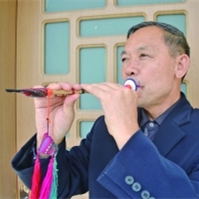Wu Ronglin

Wu Ronglin was born in 1958 in a Buyi family in Banzhao Village, Luobie Township. The Buyi nationality is a multi-talented nation that can sing and dance well. Wu Ronglin grew up listening to villagers "playing songs" since he was a child.
From the age of 7, Wu Ronglin began to learn to play the sisters' flute. Due to his hard work, he was able to perform independently on the stage at the age of eleven, and was famous for his departure.
Wu Ronglin resigned from public office in 1999 and went home. He gathered villagers who were idle and played his sister Xiao, and formed a "folk singing team" of more than 10 people. While concentrating on improving his performance skills, he began to cultivate inheritors.
In 2006, "China's 7th Folk Art Mountain Flower Festival and the National First National Singing Contest" was held in Nandaihe, Hebei. In 2008, he won the first prize in the "Huangguoshu Style Suona Contest in Guizhou Province". These honors made Wu Ronglin famous and became a "star" among the Buyi compatriots in Guizhou, and many people came to visit him for advice.
In 2008, Wu Ronglin extended the "local" inheritance to the inheritance at the social level, and he went to various local primary and secondary schools to promote it.
Because of his superb skills and active inheritance of national culture, in 2010, Wu Ronglin was appointed as the representative inheritor of the "Sister Xiao" of the Buyi nationality, a provincial intangible cultural heritage. In 2015, the Liupanshui city and county governments invested more than 200,000 yuan to set up the "Buyei Sisters Xiao Chuan Institute" in Banzhao Village, with Wu Ronglin as the teacher.
Involving musical instruments
Involved portfolio
Involved news
Popular artists
- 01 Zhang Xiuyan
- 02 Li Muliang
- 03 Chen Jun
- 04 Sun Huang
- 05 Zhang Gaoxiang
 渝公网安备 50010702504639号
渝公网安备 50010702504639号